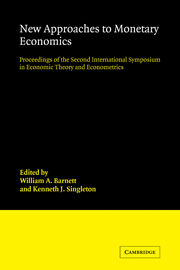 New Approaches to Monetary Economics
New Approaches to Monetary Economics Book contents
- Frontmatter
- Contents
- Editors' introduction
- List of contributors
- Part I Transactions motivated monetary holdings in general equilibrium
- 1 Monetary dynamics with proportional transaction costs and fixed payment periods
- 2 A multiple means-of-payment model
- 3 Credit policy and the price level in a cash-in-advance economy
- Part II Financial intermediation
- Part III Monetary aggregation theory
- Part IV Issues on aggregate fluctuations
- Part V Theoretical issues in the foundations of monetary economics and macroeconomics
2 - A multiple means-of-payment model
Published online by Cambridge University Press: 04 August 2010
- Frontmatter
- Contents
- Editors' introduction
- List of contributors
- Part I Transactions motivated monetary holdings in general equilibrium
- 1 Monetary dynamics with proportional transaction costs and fixed payment periods
- 2 A multiple means-of-payment model
- 3 Credit policy and the price level in a cash-in-advance economy
- Part II Financial intermediation
- Part III Monetary aggregation theory
- Part IV Issues on aggregate fluctuations
- Part V Theoretical issues in the foundations of monetary economics and macroeconomics
Summary
In this chapter we study an economy in which there are two technologies for making payments. The first is currency; the second, bank drafts drawn on interest-bearing demand deposits. The interest-bearing asset does not dominate the noninterest-bearing currency because there is a fixed recordkeeping cost incurred whenever a bank draft is used as the means of payment. The steady-state equilibrium is characterized. It is found that the value of the good or (more precisely) package of goods purchased at a given location determines which means of payment is used. Bank drafts are used for large purchases and currency for small purchases.
In the environment studied, the highly centralized Arrow–Debreu competitive equilibrium is impractical, because the number of date-, event-, and location-contingent commodities is so large that the resources required for information collection and processing would be prohibitive. In this sense we follow Brunner and Meltzer (1971) and consider as the chief role of money economizing on costly information collection and processing.
The approach is close in spirit to that of Townsend (1980), who views the payment system as a communication system. It differs in that no effort is made to find the best arrangement. The arrangement studied, however, is sufficiently explicit that one can calibrate the model and then examine the costs and benefits associated with modifying the scheme – say, by imposing reserve requirements or interest-rate ceilings. Upper bounds for the gains that can be realized from alternative systems can be computed.
- Type
- Chapter
- Information
- New Approaches to Monetary EconomicsProceedings of the Second International Symposium in Economic Theory and Econometrics, pp. 42 - 51Publisher: Cambridge University PressPrint publication year: 1987
- 24
- Cited by


